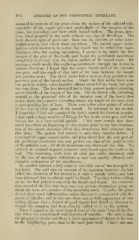Page 964 - My FlipBook
P. 964
974 DISEASES OF THE PERIDENTAL MEMBRANE.
noimced hyperemia of the gums about the molars of the affected side,
especially of the upper jaw—not particularly of the margins of the
gums, but extending over their entire buccal surface. The gums, how-
ever, fitted properly to the teeth without any sign of shrinkage. The
teeth showed signs of good care ; there was no calculus or other accu-
mulation to be seen about them anyAvhere. The second upper molar
had too much motion in its socket, but would not be called very loose.
Taking a thin, flat scaling-instrument, I passed it up under the free
margin of the gum of this tooth, and found the peridental membrane
completely destroyed over the entire surface of the buccal roots. By
passing a small needle-like exploring-instrument through the tissues in
various directions I fouiid that the entire buccal wall of the alveolus
was gone, and also nnich of that part of the bone between the buccal
and palatine roots. The third molar had a narrow, deep pocket at the
posterior part of the buccal surface. About the first molar there were
two pockets, which, taken together, almost encircled the tooth, but were
not very deep. The first bicuspid had a deep, narrow pocket extending
up two-thirds of the length of the root. On the buccal side, extending
around to the proximal side of the anterior root of the lower first
molar, there was a pocket extending almost the length of the root, with
a corresponding loss of bone. There were a few other points of attack
of less note in other parts of the mouth. By reference to my records
I found that I had not examined the lady's mouth for fourteen months.
I had made a large number of fillings for her in the years past, and had
kn()^vn her as a very careful patient. I feel very certain that there
could have been no beginning of this disease prior to my last examina-
tion of the mouth, therefore all of this destruction had occurred since
that time. The patient had noticed it only three months before. I
extracted the upper second molar, and then found that the only part of
the peridental membrane that was perfect was that of the palatine side
of the palatine root ; all of tlie membrane was destroyed but this. No
salivary or serumal deposits whatever were found upon the tooth or its
root. The remaining teeth were at once put under treatment, and
by the use of antiseptic stimulants a cure was readily effected, with
complete restoration of the membranes.
In another instance a lady came to me with one of her bicuspids in
her hand. She said that on account of its apparent looseness she had
called the attention of her dentist to it only a month before, and had
been informed that no disease could be found. Two days before calling
on me she had picked it out with the thumb and finger. An examina-
tion revealed the fact that there Avas very serious destruction going on
al)out the roots of a number of the remaining teeth. Usually, the gums
do not sliow much inflammation unless the case is complicated with de-
posits of calculus, and in this case there was so little appearance of any
serious disease that a dentist of good repute had failed to discover it,
though his attention had been directly called to it by the patient.
These I regard as the most typical cases of the acute form of the dis-
ease when not complicated with deposits of calculus. The rule is that
the progress is slower and there is more appearance of disease to be seen
in the neighboring parts than in the cases just cited. I have one case


